Introduction
Thermal management is a critical issue in high-power laser diode and LED packages, and microprocessor units [1, 2]. Reliability and long life time of electronic packages call not only for materials with high thermal conductivity but also a coefficient of thermal expansion (CTE) matching to that of semiconductors. The thermal expansion of the heat sink material in electronic packaging should be compatible with that of the semiconductor, i.e, CTE between 4-7 ppm/K. The CTE can be tailored for a specific application by using a reinforcement material with lower thermal expansion and by varying the volume fractions of the constituents. Among all the reinforcements, diamonds are attractive as they have superior thermal conductivity (1000-1500 W m-1 K-1 for commercially available industrial diamonds) and the ever decreasing prices encouraging market realization.
There has been quite some skepticism and misinformation on diamond composites due to lack of systematic testing and reporting of results. This article intends to bring the thermal engineer a little closer to the realities of these promising diamond composite thermal management materials in regards to thermal properties, thermal reliability, environmental stability and the feasibility of integrating into a package.
Technology and Material Characteristics
Metal diamond composites were produced by gas pressure assisted infiltration (GPI) of specific metal alloys (Ag, Al, Cu alloys) with high conductivity diamond particles. Since diamond wets the metals rather poorly, certain alloying elements were added to these alloys for better bonding between diamond and the metal matrix. Commercially available diamond powders of US 70/80 mesh were used. The quality and volume content of the diamond has a strong effect on the final thermal conductivity of the composite.
The diamond particles were filled in the graphite molds to a desired final composition (> 50 vol.% diamond). The filled molds were sealed and evacuated to a vacuum to remove trapped air in the mold. The mold was then heated in a vacuum furnace to above the melting temperature of the alloy and held at this temperature for a few minutes before applying a gas pressure to infiltrate the molten alloy into the mold. After infiltration the mold was furnace cooled. The schematic of the process is shown in Figure 1. Detailed information regarding the process and applications of diamond composites are reported elsewhere [3, 4]. As it stands today, gas pressure infiltration technology has been scaled to an industrial level to commercially produce in high volumes. These diamond composites have started to see applications in micro-, opto- and power electronics.
 |
Figure 1. Schematic of the gas pressure infiltration process.
The diamond composite samples were characterized for density, surface roughness, thermal conductivity, and coefficient of thermal expansion. The sample density was measured using the standard Archimedes density principle in accordance with ISO 3369. The surface roughness was measured using a TK100 surface analyzer in accordance with DIN 4777. CTE was measured with a Netzsch model 402 C push rod dilatometer. The samples were tested in a dynamic helium atmosphere (gas flow rate: 50ml/min) between 10 and 160�C at a heating rate of 3K/min. Further on, the reproducibility was checked by measuring the same sample twice. The thermal diffusivity and specific heat were measured using a Netzsch model LFA 447 Nanoflash™ diffusivity apparatus. For this, the system was calibrated with an aluminum standard prior to the sample test run.
Existing thermal management materials in electronic packaging are shown in Figure 2. Metals such as silver, copper and aluminum have good thermal conductivity but suffer from the drawback of higher CTE in comparison to semiconductor materials. The CTE mismatch between these metals and semiconductor materials causes thermal stresses during operation leading to thermo-mechanical failure during operating life times. In the case of a good CTE match composites such as AlSiC, CuW, MoCu suffer from low thermal conductivity.
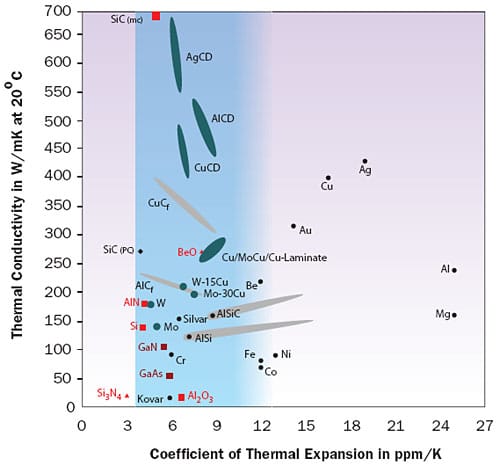 |
Figure 2. Existing thermal management materials in electronics packaging.
On the other hand as seen in Figure 2, diamond composites in specific silver-diamond (AgCD), aluminum-diamond (AlCD) and copper-diamond (CuCD) composites produced via GPI have higher thermal conductivity than copper with a matching CTE to that of the semiconductor materials, and ceramics used in packages making them attractive as thermal management solutions in electronic packaging. Detailed physical and thermal properties of metal diamond composites are shown in Table 1.
Table 1. Thermal Properties of Diamond Composites Measured at 20�C
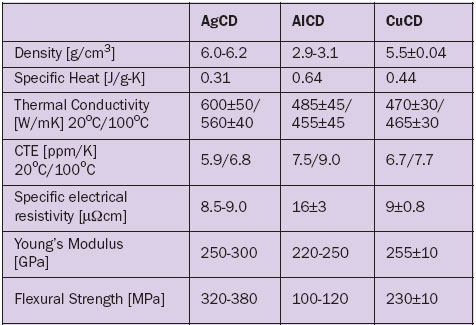 |
(Note: Thermal conductivity and coefficient of thermal expansion values are shown both at 20�C and 100�C.)
Role of Interface
Thermal reliability and environmental testing results were performed according to the JESD A-104C and JESD A-102C. The thermal properties of diamond composites decrease upon thermal cycling and humidity tests [5]. The percent change or drop in thermal conductivity after thermal cycling depends on the alloy composition. Silver diamond composites show negligible change in thermal properties after thermal cycling and humidity tests. Copper based diamond composites show a 5-10% decrease in thermal conductivity upon thermal cycling, but no degradation or damage during humidity tests. Aluminum diamond composites, owing to their hygroscopic nature, degrade during humidity tests. This however can be circumvented by coating the aluminum diamond composite parts with dense Ni barrier coatings.
The metal-diamond interface plays an extremely crucial role in diamond composites in regards to the thermal properties and stability of the composites. The interface must provide a mechanically stable bond between the diamond and the metal matrix but is also responsible for the heat transfer between the diamond and the metal. The custom alloys with specific alloying additions build carbides at the diamond providing such a thermally stable interface. These interfaces are stable at room temperature and are also shown to survive the thermal cycling and environmental tests [5]. Figure 3 exemplifies the interface in a silver diamond composite after thermal cycling test and it can be observed that the interface is intact. No micro voids or delaminations have been detected.
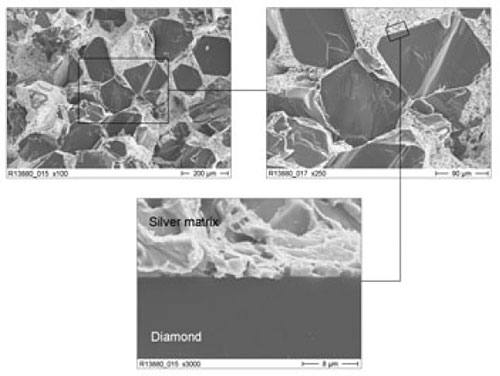 |
Figure 3. Fracture surface of silver diamond composite after thermal cycling test according to JEDEC A104-C.
Integration into Packages
The integration of diamond composites into existing packages allows for better overall performance. Owing to near net shape infiltration technology and advanced cutting techniques, diamond composites can be manufactured into various shapes (with features such as through holes, chamfers, etc.) and sizes ( varying from 10 x 10mm to 180 x 180mm with thicknesses from 1.2mm to 6 mm) which are suitable for many existing and future package designs.
Table 2. Standard Sizes and Tolerances of Diamond Composites
 |
Table 3. Surface Finish and Flatness Achievable in Standard and Metallized Condition
 |
Table 2 indicates the current sizes available and Table 3 indicates the surface finish, flatness and coatings achievable. Additionally, the surface of the diamond composites can be metallized with silver or copper in order to provide a machinable surface which allows high-precision machining of the component. A cross-section of a metallized surface is shown in Figure 4. Additional metallization and coatings, such as Ni and Au provide render an oxide free surface and a diffusion barrier for die attach to the semiconductor material.
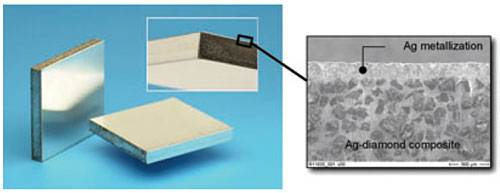 |
Figure 4. Cross section of diamond composite heat spreader with silver layer.
For every specific application at hand, it must be evaluated if it is reasonable to replace the existing copper spreader designs one-to-one with diamond composites. It might be necessary to modify heat spreader designs in order to benefit from the high thermal conductivity/ low thermal expansion of diamond composites to improve thermal efficiency and reliability of electronic packages.
Cost Considerations
The cost of the diamond composites is determined by the features necessary in a given application. As a rule of thumb diamond composites cost a factor of 2-3 higher than existing composite materials, as seen in Figure 5. However, one should keep in mind that the total thermal management ownership cost could be similar, if one takes into account the fan, and the space constraints that existing solutions impose on the miniature design of the packages, and the lifetime of the packages. In some cases, the existing materials can not simply deal with the thermal loads, making diamond composite priceless.
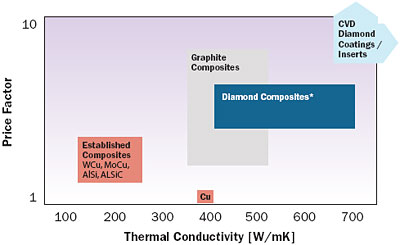 |
Figure 5. Cost comparison of the diamond composites with existing thermal management materials for a simple geometry of 45mm x 45mm x 2mm spreader. *As manufactured by the GPI process [3,4]
Conclusions
Diamond composites have superior thermal conductivity and a CTE matching to that of the semiconductor materials. These advanced composite materials are capable of providing thermal management solutions at the heat spreader level for main applications such as lids for CPUs, heat sinks for laser diodes and also as base plates in power electronics. A battery of standard thermal tests performed on these diamond composites provide the thermal engineers with reliable thermal data over the operating temperature range for simulation and design of packages. Through optimization of alloy composition, diamond grade, content, and surface metallization techniques, the diamond composites can be tailored to the specific applications and easily integrated into various electronic packages.
References
- Zweben, C., ” ‘Revolutionary’ New Thermal Management Materials,” ElectronicsCooling, May 2005, Vol. 11, No. 2
- Tonapi, S. S, Fillion, R. A, Schattemann, F. J, Cole, H. S, Evans, J. D, ” An Overview of Thermal Management for Next Generation Microelectronic Devices,” IEEE/SEMI Advance Manufacturing Conference, pp. 250-254, 2003.
- R. Bollina, M. Stoiber, “Ultra High Conductivity Diamond composites,” Proceedings of Powder Metallurgy, Busan, Korea, Sept 24-28, 2006.
- R. Bollina, J. Landgraf, H. Wagner, R. Wilhelm, S. Knippscheer, and B. Tabernig, “Performance, Production and Applications of Advanced metal Diamond Composite Heat Spreader,” IMAPS, Advanced Technology Workshop on Thermal Management, Palo Alto, Ca, USA, Sept 11-13, 2006.
- R. Bollina, J. Landgraf, H. Wagner, R. Wilhelm, S. Knippscheer, S. Levchuk, and G. Mitic, “Thermal reliability and Environmental Testing of Advanced Metal Diamond Composites,” Proceedings of IPACK2007-ASME InterPACK, Vancouver, BC, July 8-12, 2007.






